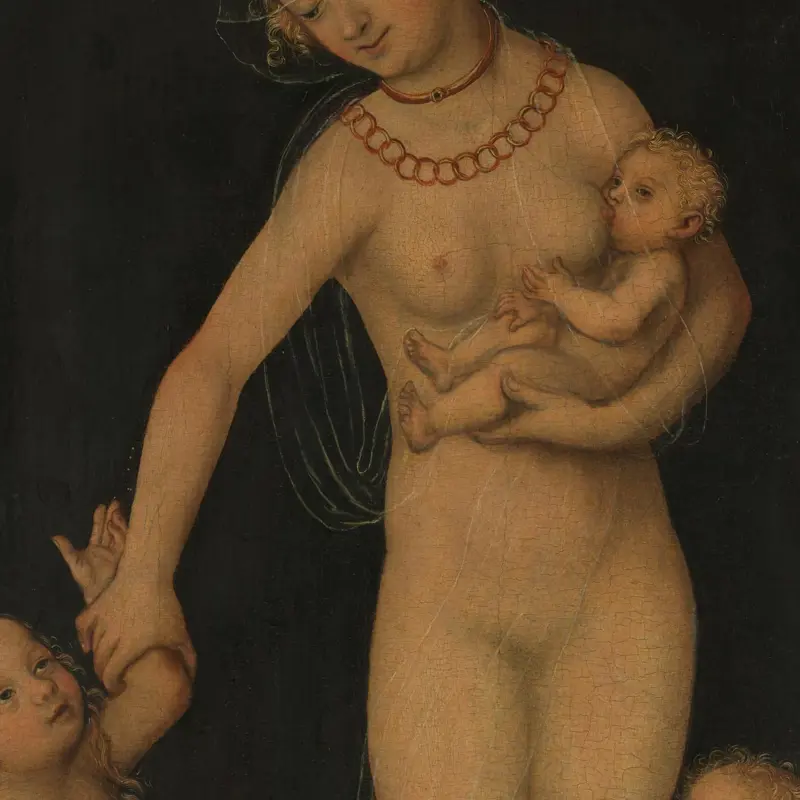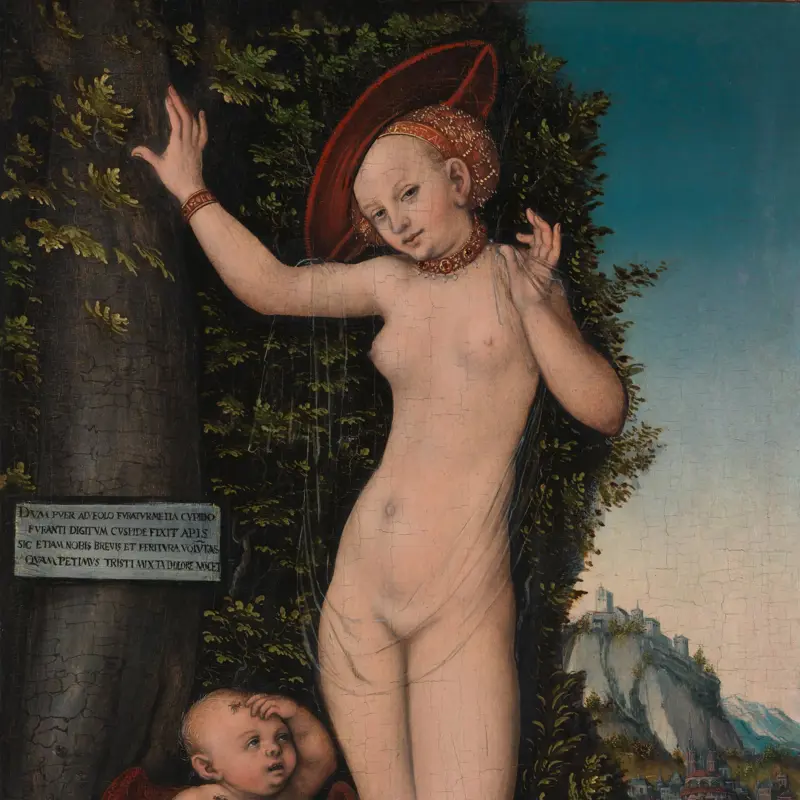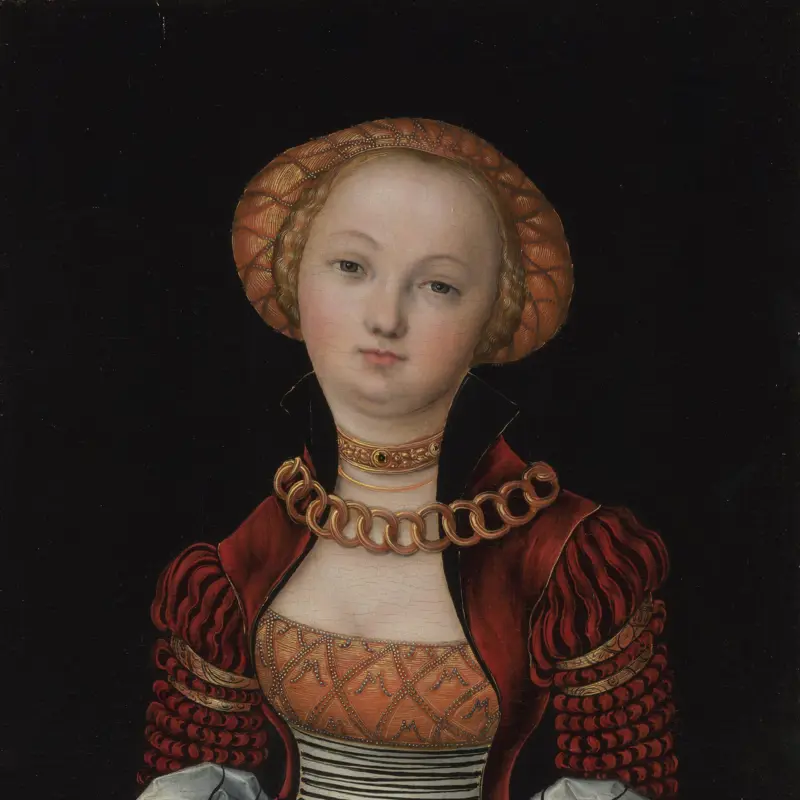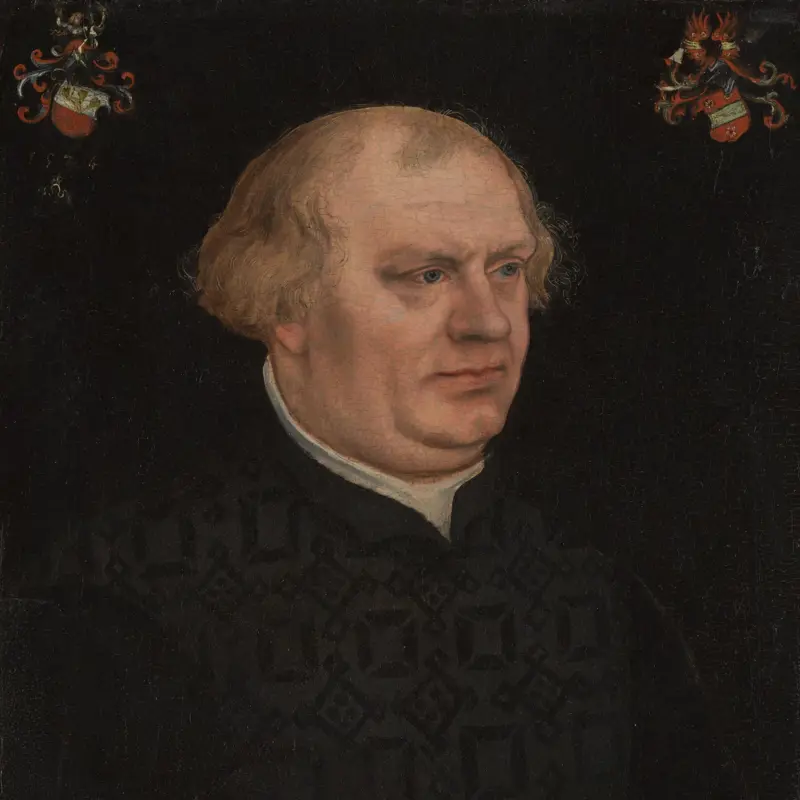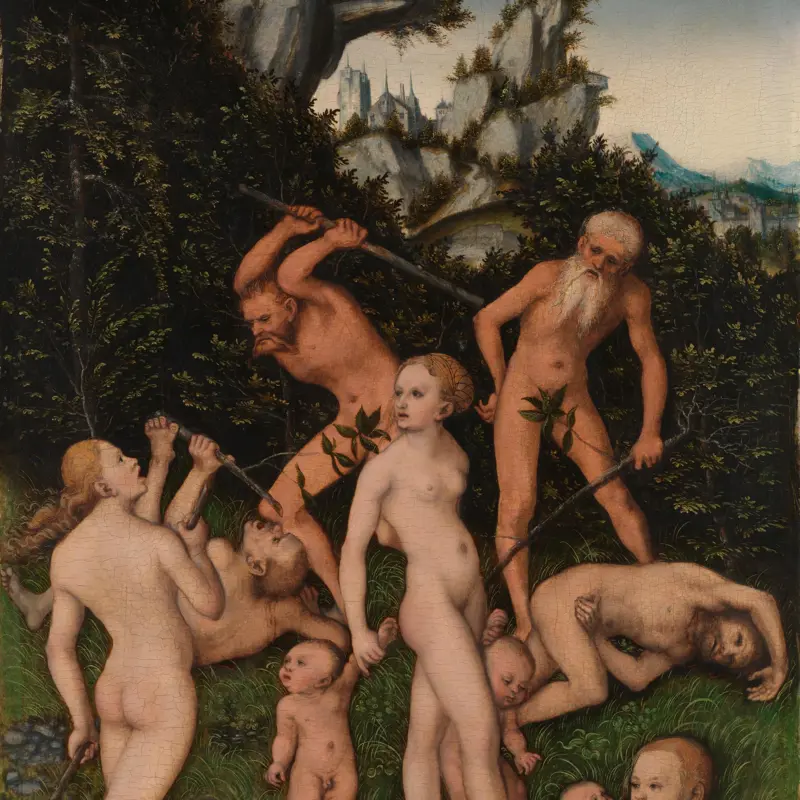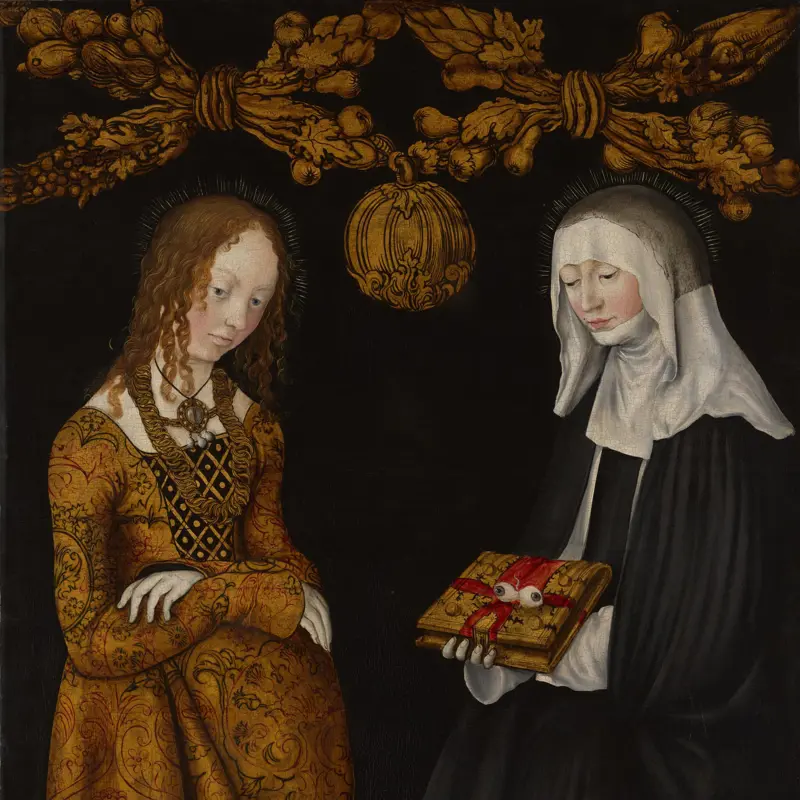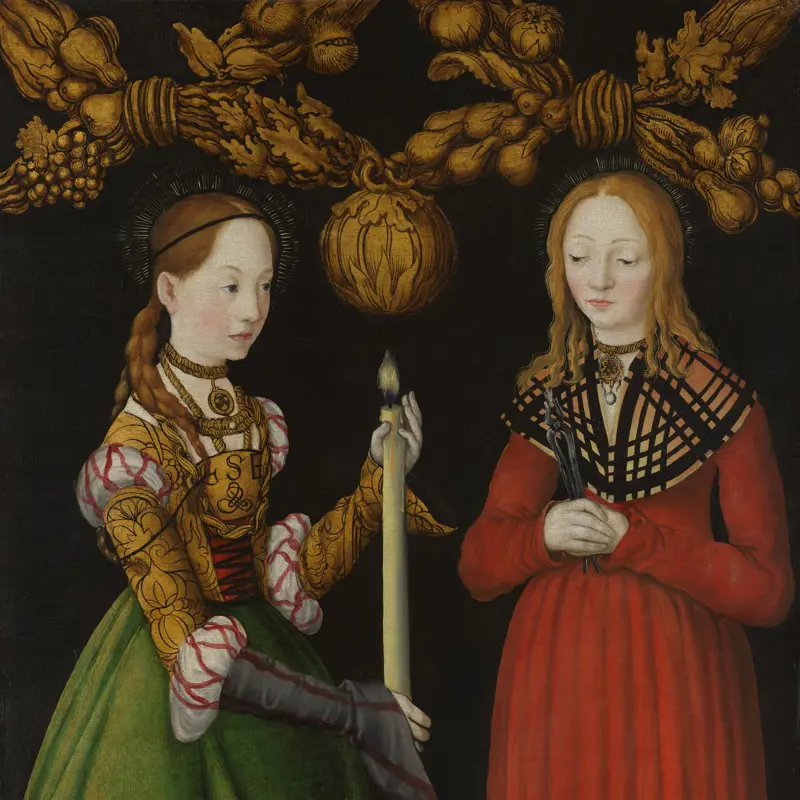Lucas Cranach the Elder, 'Cupid complaining to Venus', 1526-7
About the work
Overview
Cupid, the god of erotic love, is complaining to his mother, Venus, the goddess of love: he has been stung by bees after stealing a honeycomb. Venus directs her attention towards the viewer instead. Her narrowed gaze appears flirtatious and she clutches the branch of an apple tree, evocative of the biblical temptress Eve.
This is a morality tale, based on a Greek poem from the third century BC – though Venus wears a velvet hat and jewelled choker in the style of those worn at the Saxon court where Cranach worked from 1505. The poem describes how life’s pleasures are mixed with pain, as the inscription at the top of the painting observes. Venus explains to her son that the wounds of love he inflicts with his arrows are far worse than any physical pain he may be experiencing.
Key facts
Details
- Full title
- Cupid complaining to Venus
- Artist
- Lucas Cranach the Elder
- Artist dates
- 1472 - 1553
- Date made
- 1526-7
- Medium and support
- oil, originally on wood, transferred to board
- Dimensions
- 81.3 × 54.6 cm
- Inscription summary
- Signed; Inscribed
- Acquisition credit
- Bought, 1963
- Inventory number
- NG6344
- Location
- Room 55
- Collection
- Main Collection
- Frame
- 20th-century Replica Frame
Provenance
The picture is first recorded in the sale of the collection of Emil Goldschmidt (1848–1909), Frankfurt, at Rudolph Lepke, Berlin, on 27 April 1909, lot 48, clearly identified through the photograph in the sale catalogue. The purchaser at the 1909 sale was an art dealer who has not been identified.
This may be the painting by Lucas Cranach of ‘Venus und Amor als Honigdieb’, of similar but not identical dimensions, that was recorded as being sold by the widow of the Chemnitz businessman Hans Hermann Vogel (1867– after 1931) through Heinemann in Munich on 12 September 1935 to ‘Allmer, Berlin’. The latter can possibly be identified as Robert Allmers (1872–1951), president of the German Automobile Industry Association. It was acquired by Adolf Hitler (1889–1945) at an unknown date and is recorded in a photograph in an album that includes works from his private collection displayed at the Berghof, Berchtesgarten, Obersalzberg. Hitler was said in 1947 to have had a painting by Cranach of ‘Venus and Amor’ in the flat in Munich in which he lived from 1929 onwards. The painting may have been the work acquired by him in or before 1937, when he is said to have owned a recently acquired but unspecified work by Cranach. It may be the painting by Cranach that he is said to have acquired with royalties from the sales of Mein Kampf.
The painting was owned from 1945 by Mrs Patricia Lochridge Hartwell (1916–1998), an American war correspondent who was permitted to select it from a warehouse controlled by American forces in southern Germany in 1945. Mrs Hartwell sold it in 1963 through E. & A. Silberman, New York; according to Silberman it was sold ‘by family descendents’ of the purchasers at the 1909 sale. It was bought by the National Gallery from Silberman in 1963.
Additional information
This painting is included in a list of works with incomplete provenance from 1933–1945; for more information see Whereabouts of paintings 1933–1945.
Text extracted from the ‘Provenance’ section of the catalogue entry in Susan Foister, ‘National Gallery Catalogues: The German Paintings before 1800’, London 2024; for further information, see the full catalogue entry.
Exhibition history
-
2014Strange Beauty: Masters of the German RenaissanceThe National Gallery (London)19 February 2014 - 11 May 2014
-
2020Cranach: Artist and InnovatorCompton Verney14 March 2020 - 3 January 2021
Bibliography
-
1894G. Bauch, 'Zur Cranachforschung, 5: Der Honigdieb', Repertorium für Kunstwissenschaft, XVII, 1894, pp. 434-5
-
1965The National Gallery, The National Gallery: June 1962 - December 1964, London 1965
-
1974D. Koepplin and T. Falk, Lukas Cranach: Gemälde, Zeichnungen, Druckgraphik, (exh. cat. Kunstmuseum, 15 June - 8 September 1974), Basel 1974
-
1978M.J. Friedländer and J. von Rosenberg, The Paintings of Lucas Cranach, revised edn, London 1978
-
1984F.W.G. Leemann, 'A Textural Source for Cranach's "Venus with the Honey-Thief"', The Burlington Magazine, CXXVI/974, 1984, pp. 274-5
-
1985A. Smith, Early Netherlandish and German Paintings, London 1985
-
1993R. White and J. Pilc, 'Analyses of Paint Media', National Gallery Technical Bulletin, XIV, 1993, pp. 86-94
-
1994C. Grimm, J. Erichsen and E. Brockhoff, Lucas Cranach: Ein Maler-Unternehmer aus Franken (exh. cat. Festung Rosenberg, May - July 1994), Augsburg 1994
-
1997R. Billinge et al., 'Methods and Materials of Northern European Painting in the National Gallery, 1400-1550', National Gallery Technical Bulletin, XVIII, 1997, pp. 6-52
-
2001
C. Baker and T. Henry, The National Gallery: Complete Illustrated Catalogue, London 2001
-
2002D. Bomford et al., Underdrawings in Renaissance Paintings (exh. cat. The National Gallery, 30 October 2002 - 16 February 2003), London 2002
-
2003S. Foister et al., Lucas Cranach: Glaube, Mythologie und Moderne (exh. cat. Bucerius Kunst Forum, 6 April - 13 July 2003), Ostfildern-Ruit 2003
-
2005T. Chevalier and C. Wiggins, Tom Hunter: Living in Hell and Other Stories, (exh. cat. The National Gallery, 7 December 2005 - 12 March 2006), London 2005
-
2007P. Pérez d'Ors, 'A Lutheran Idyll: Lucas Cranach the Elder's Cupid Complaining to Venus', Renaissance Studies, XXI/1, 2007, pp. 85-98
-
2007C. Campbell, Temptation in Eden: Lucas Cranach's Adam and Eve (exh. cat. The Courtauld Gallery, 21 June - 23 September 2007), London 2007
-
2024S. Foister, National Gallery Catalogues: The German Paintings before 1800, 2 vols, London 2024
Frame
This reproduction frame was made at the Gallery after 1963. A polychrome and gilt box frame made in pinewood, it emulates a Northern European style. The top portion of the stepped outer moulding is painted black. Painted marbling over the frieze complements the landscape in Cranach’s Cupid complaining to Venus. There is a water-gilt moulding at the sight edge.
The frame was probably crafted by F.A. Pollak, a framer at the Gallery who had fled Germany during the Second World War.
About this record
If you know more about this work or have spotted an error, please contact us. Please note that exhibition histories are listed from 2009 onwards. Bibliographies may not be complete; more comprehensive information is available in the National Gallery Library.

